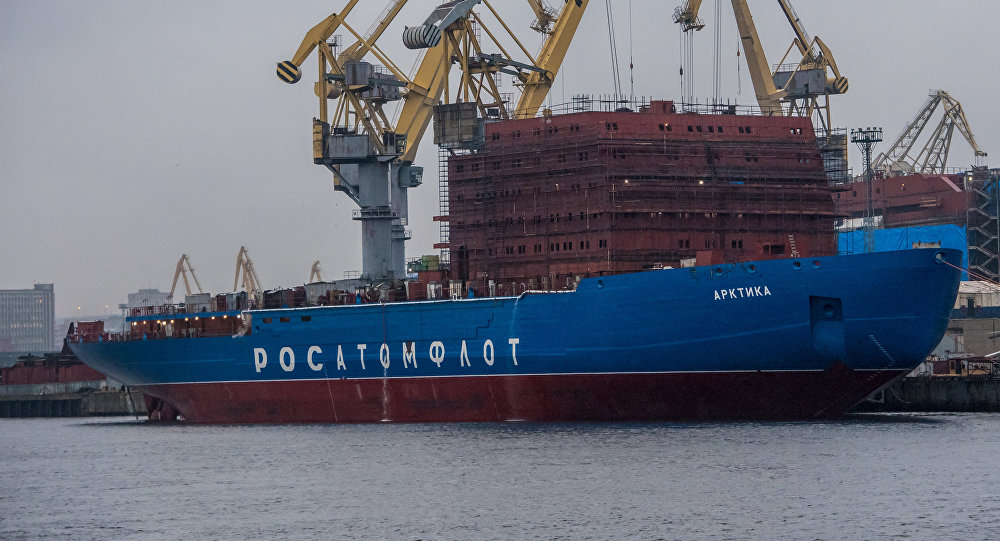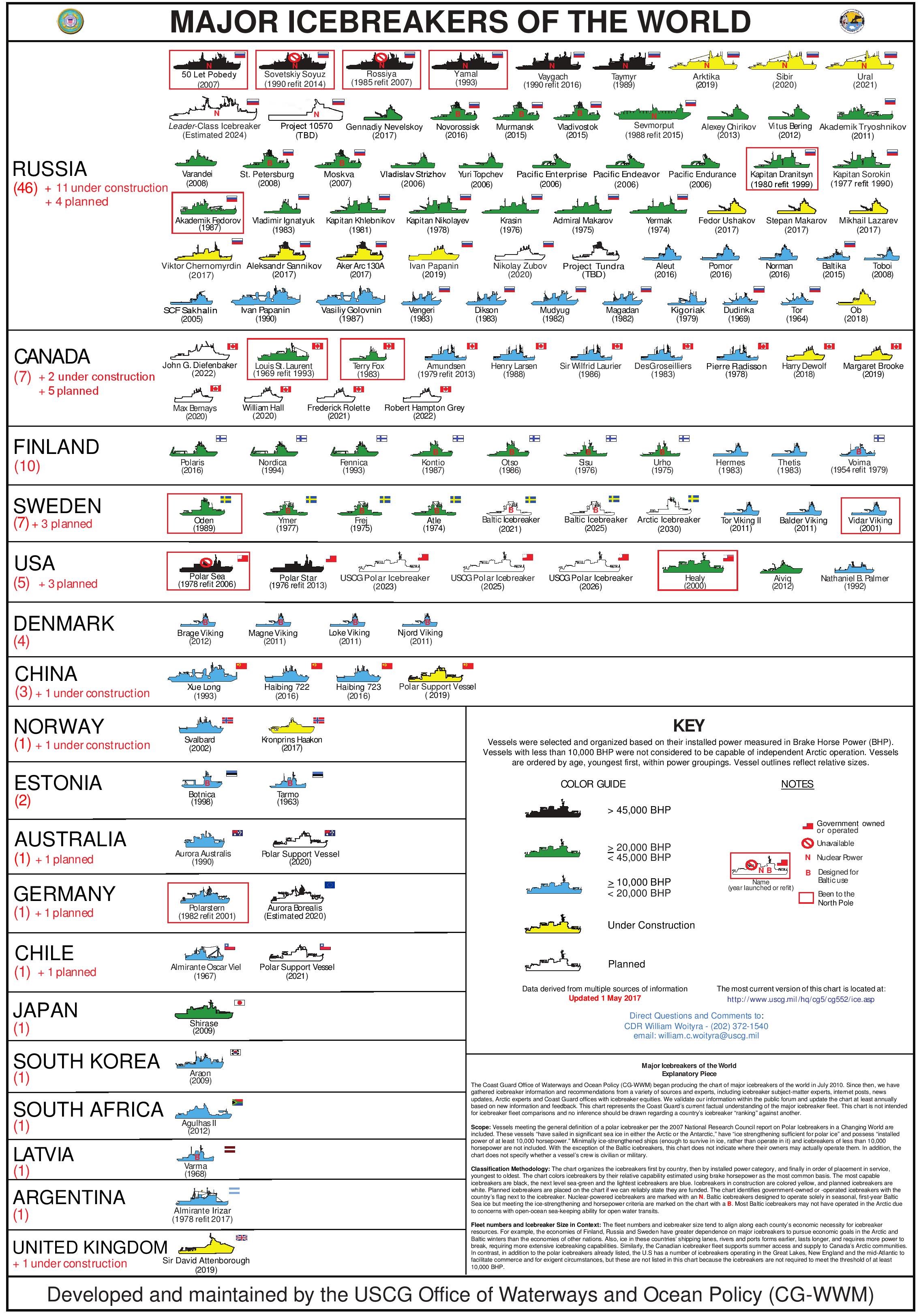Tests of the world’s most powerful nuclear-powered icebreaker, the Russian “Arktika” began in St. Petersburg, the Russian Ministry of Defense’s Zvezda TV reported.
Experiments to test the strength of the future icebreaker are held at the Krylov Research Center, a site with virtually no equal on global scale.
Experts are testing the strength and durability of the ship with severe overloads. In the video, the five-meter model of the future Arctic ship is crushing four-centimeter ice. If we calculate it to relate to its actual scale, then this is an analogue of the movement of the huge icebreaker through ice with a 1.5-meter thickness.
“In the course of these experiments, we determine the possibility of forcing ice conditions on the ship or the possibility of the ship to moving while being escorted by the icebreaker,” explained Alexei Dobrodeev, head of the ice-technology research department of the Krylov State Research Center.
The Krylov Research Center has dozens of different basins where models of future ships can be checked for seaworthiness and running indicators. One of the deep-water basins located here is the largest in the world, its length is almost 1.5 kilometers. It was here that the hulls of all ships built in our country over the past 60 years were tested.
“These tests are conducted to determine or confirm the sailing quality of the designed ship. At the stage of a model experiment, it is important to make sure that a full-scale ship will reach those parameters that are written in its specifications,” Sergey Kaprantsev, head of the laboratory of the driving performance of surface ships, said.
The Krylov Research Center also tests all Russian submarines in addition to surface ships. Civil vessels for Japan, China, Greece and Australia were tested also tested in the basins, since all conditions can be simulated at the facility – from storms to hurricanes.
It also can test other constructions too; it was in the wind tunnel at the center that the prototypes of the spans of the Crimean bridge and even the new Petersburg stadium were tested.
In its over 125 years of work, almost 12 thousand models of various vessels have been tested at the Krylov Research Center.
Russia is currently the only country in the world operating nuclear-powered icebreaker and it has the largest fleet. Recently, Russian Deputy Prime Minister Yuri Borisov confirmed that by March 15th the order to start construction on an enormous icebreaker.
The icebreaker in question is the Leader – or Lider in Russian – a ship of futuristic, almost fantastical, proportions that first debuted on the pages of a slick Russian trade magazine four years ago. But what at first looked like an expensive dream has gathered momentum in official circles, and now the government is mobilizing billions of dollars to revamp the Zvezda shipyard, a nearly defunct naval installation Vladivostok, to build the vessel.
The Leader first appeared as a mere artist’s rendition on the cover of the United Shipbuilding Corporation’s company magazine in 2015.
Its dimensions: 205 meters (673 feet) and 71,000 tons, it would be 50 meters (164 feet) longer and thousands of kilograms heavier than Russia’s three largest icebreakers – which are themselves still under construction.
Its two experimental RITM 400 reactors would be capable of propelling it through the thickest ice the Arctic can dish out, while maintaining a hull shallow enough to make it useful in navigating the Arctic’s river tributaries.
And the Leader’s maintenance needs, according to engineers, would be minimal. As described in reports by Russia’s shipbuilding trade press, the Leader would be built of materials capable of “self-diagnosing” metal corrosion and would further be able to “self-heal” when damage is detected.
This is in line with an interview with Borisov by TASS on March 3rd. In it, the Deputy PM said that “this territory [the Arctic] is [in] Russia’s sphere of interests. We will not will not abandon it and will not hand it over.”
Earlier, the commander of the US Navy in Europe and Africa, Admiral James Foggo said that the Arctic should remain a free and open space, despite the fact that Russia considers it its territory. In November 2018, General Joseph Dunford, Chairman of the Joint Chiefs of Staff, expressed the view that Russia is expanding its military presence in the Arctic and the United States does not rule out the possibility of turning this region into a conflict zone in the future.
Moscow has consistently rejected the claims of Western politicians about building up their military presence in other regions and about any actions that are supposedly aimed at violating the international order.
Major-General Sergey Lipov, the head of the “Officers of Russia” organization also commented on the situation in the Arctic, saying that the US lack the capacity to compete with Russia in the arctic. He also reiterated the massive economic interests Russia has in the region.
“In addition to economic interests that are huge, there is also the issue of national security, because the Arctic is the shortest direction for a strike on Russia from the United States, there are routes for US Air Force strategic bombers via the Arctic. That is why we finally began to restore our military presence there. And the resources that we currently dispose of there – the Arctic search stations, ports and airfields, air defense stations and, of course, the nuclear icebreaking fleet – make us full-fledged owners of the Arctic region.”
Also, upcoming is the Arctic: Territory of Dialogue international forum, scheduled in St. Petersburg on April 9th – 10th. It is a key platform for discussing the Arctic region’s problems and development at the international level. The event was organized for the first time in 2010.
On March 14th, Admiral Nikolai Evmenov, commander of the Northern Fleet, said: “Russia’s security in the Arctic is a priority task for the Northern Fleet… And special attention is accorded to the Arctic military exercises. This applies to naval aviation and submarine forces, both of strategic and general purpose. Seven military exercises along the Northern Sea Route have already been completed. A unique landing of an amphibious assault troops on the coast of the mainland and islands of Franz Josef Land archipelago in the West and Bering Strait in the East took place. In order to successfully perform combat missions in the Arctic, the Northern Fleet receives modern equipment, including some that were not previously used by the Armed Forces and first and foremost the icebreaker Ilya Muromets.”
China is also developing its 33,069-ton nuclear icebreaker, designed to smash and grind its way through ice-covered waters. The state-owned China General Nuclear Power Group just passed its Wednesday deadline for accepting bids from Chinese companies interested in actually building the 152-meter ship.
The purpose of the ship, according to Western Media is to establish dominance in the Arctic region.
Meanwhile, the US maintains that Russia (and potentially soon China too) is building up military presence in the Arctic and is threatening the security of the region. The US is looking to expand its lackluster icebreaker fleet, but is uncertain how to do it.
The following infographic released by the U.S. Coast Guard Office of Waterways and Ocean Policy provides a general look at the global situation in terms of Arctic potential.
Of those heavy icebreakers, America only has one operational. Russia, on the other hand, has two operational with four more in refit. Once refits are complete, Russian heavy icebreakers will outnumber the American ones 3:1, providing Russia with better capability to run operations in heavy ice packs.








“Possibly for the first time since Montreux Treaty was signed in 1936, a Russian submarine transited Bosphorus towards Mediterranean. Montreux Treaty Article 12 allows only Black Sea riparian states’ submarines to transit Bosphorus, and only for repairs.”
https://twitter.com/YorukIsik/status/1106190507909222400
The UK has one under construction …. talk about setting your priorities right.
I didn’t know that. What’s it called,…. HMS “Brexit”? ;-)
Probably, never ending and then cancelled.
“””and now the government is mobilizing billions of dollars to revamp the Zvezda shipyard, a nearly defunct naval installation Vladivostok, to build the vessel.
The Leader first appeared as a mere artist’s rendition on the cover of the United Shipbuilding Corporation’s company magazine in 2015.
Its dimensions: 205 meters (673 feet) and 71,000 tons, it would be 50 meters (164 feet) longer and thousands of kilograms heavier than Russia’s three largest icebreakers – which are themselves still under construction.”””
Zvezda shipyard will have the capacity to build large tonnage ships, heavy destroyers, helicopter carriers and other large ships. The dimensions and tonnage of the Leader icebreaker are impressive and point to the possibility of Russia being able to build 100,000 tons carriers. The Leader icebreaker most likely will carry some armaments, to make use of its 71,000 tons displacement, it remains to be seen how the ship will be equipped.